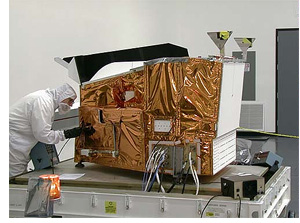Links to Related Websites
MODIS Instrument
 MODIS (or Moderate Resolution Imaging Spectroradiometer) is a key instrument aboard the Terra and Aqua satellites. Terra MODIS and Aqua MODIS are viewing the entire Earth's surface every 1 to 2 days, acquiring data in 36 spectral bands, or groups of wavelengths. These data will improve our understanding of global dynamics and processes occurring on the land, in the oceans, and in the atmosphere. MODIS is playing a vital role in the development of validated, global, interactive Earth system models able to monitor and predict global changes.
MODIS (or Moderate Resolution Imaging Spectroradiometer) is a key instrument aboard the Terra and Aqua satellites. Terra MODIS and Aqua MODIS are viewing the entire Earth's surface every 1 to 2 days, acquiring data in 36 spectral bands, or groups of wavelengths. These data will improve our understanding of global dynamics and processes occurring on the land, in the oceans, and in the atmosphere. MODIS is playing a vital role in the development of validated, global, interactive Earth system models able to monitor and predict global changes.
MODIS Instrument Specifications:
- Orbit: 705 km, 10:30 a.m. descending node (Terra); 1:30 p.m. ascending node (Aqua), sun-synchronous, near-polar, circular
- Scan Rate: 20.3 rpm, cross track
- Swath Dimensions: 2330 km (cross track) by 10 km (along track at nadir)
- Spatial Resolution: 250 m (bands 1-2), 500 m (bands 3-7), 1000 m (bands 8-36)
MODIS Spectral Bands:
| Primary Use | Band | Bandwidth1 | Spectral Radiance2 | Required SNR3 |
|---|---|---|---|---|
| Land Boundaries Cloud Boundaries Aerosols Boundaries |
1 | 620 - 670 nm | 21.8 | 128 |
| 2 | 841 - 876 nm | 24.7 | 201 | |
| Land Properties Cloud Properties Aerosols Properties |
3 | 459 - 479 nm | 35.3 | 243 |
| 4 | 545 - 565 nm | 29.0 | 228 | |
| 5 | 1230 - 1250 nm | 5.4 | 74 | |
| 6 | 1628 - 1652 nm | 7.3 | 275 | |
| 7 | 2105 - 2155 nm | 1.0 | 110 | |
| Ocean Color Phytoplankton Biogeochemistry |
8 | 405 - 420 nm | 44.9 | 880 |
| 9 | 438 - 448 nm | 41.9 | 838 | |
| 10 | 483 - 493 nm | 32.1 | 802 | |
| 11 | 526 - 536 nm | 27.9 | 754 | |
| 12 | 546 - 556 nm | 21.0 | 750 | |
| 13 | 662 - 672 nm | 9.5 | 910 | |
| 14 | 673 - 683 nm | 8.7 | 1087 | |
| 15 | 743 - 753 nm | 10.2 | 586 | |
| 16 | 862 - 877 nm | 6.2 | 516 | |
| Atmospheric Water Vapor | 17 | 890 - 920 nm | 10.0 | 167 |
| 18 | 931 - 941 nm | 3.6 | 57 | |
| 19 | 915 - 965 nm | 15.0 | 250 | |
|
|
||||
| Primary Use | Band | Bandwidth1 | Spectral Radiance2 |
Required NE[Δ]T(K)4 |
| Surface Temperature Cloud Temperature |
20 | 3.660 - 3.840 µm | 0.45(300K) | 0.05 |
| 21 | 3.929 - 3.989 µm | 2.38(335K) | 2.00 | |
| 22 | 3.929 - 3.989 µm | 0.67(300K) | 0.07 | |
| 23 | 4.020 - 4.080 µm | 0.79(300K) | 0.07 | |
| Atmospheric Temperature | 24 | 4.433 - 4.498 µm | 0.17(250K) | 0.25 |
| 25 | 4.482 - 4.549 µm | 0.59(275K) | 0.25 | |
| Cirrus Clouds Water Vapor |
26 | 1.360 - 1.390 µm | 6.00 | 150(SNR) |
| 27 | 6.535 - 6.895 µm | 1.16(240K) | 0.25 | |
| 28 | 7.175 - 7.475 µm | 2.18(250K) | 0.25 | |
| Cloud Properties | 29 | 8.400 - 8.700 µm | 9.58(300K) | 0.05 |
| Ozone | 30 | 9.580 - 9.880 µm | 3.69(250K) | 0.25 |
| Surface Temperature Cloud Temperature |
31 | 10.780 - 11.280 µm | 9.55(300K) | 0.05 |
| 32 | 11.770 - 12.270 µm | 8.94(300K) | 0.05 | |
| Cloud Top Height | 33 | 13.185 - 13.485 µm | 4.52(260K) | 0.25 |
| 34 | 13.485 - 13.785 µm | 3.76(250K) | 0.25 | |
| 35 | 13.785 - 14.085 µm | 3.11(240K) | 0.25 | |
| 36 | 14.085 - 14.385 µm | 2.08(220K) | 0.35 | |
|
|
||||
| 1 Bands 1 to 19 are in nm; Bands 20 to 36 are in µm 2 Spectral Radiance values are (W/m2 -µm-sr) 3 SNR = Signal-to-noise ratio 4 NE(Δ)T = Noise-equivalent temperature difference |
||||
Spectrum:
In the MODIS spectral band (or spectral wavelength) table above, the bandwidth (column 3) for bands 1 through 19 are shown in nm (nanometers), while bands 20 through 36 are shown in µm (micrometers or microns). Note that µm can be converted to nm by multiplying by 1000; so the value 5.0 µm (which is roughly around band 25) is the same as 5000 nm, which is in the infrared (IR) portion of the spectrum. The spectrum of visible light goes from about 380 nm (indigo or deep purple) to 720 nm (maroon or deep red). The green band runs from about 520 to 580 nm.


